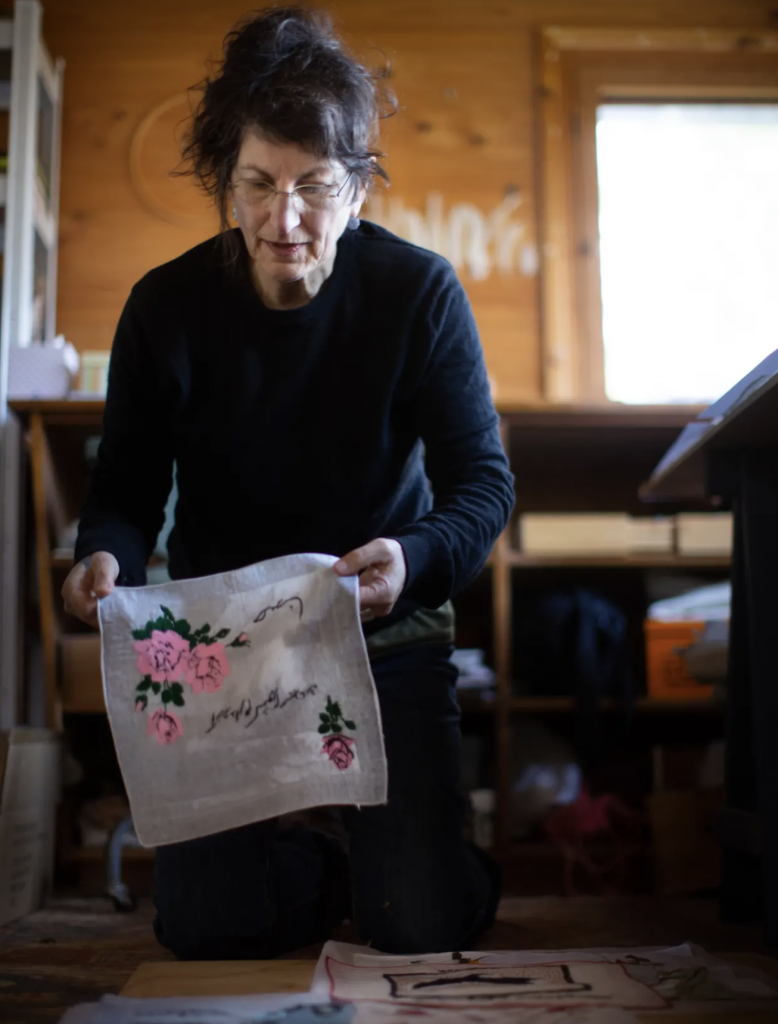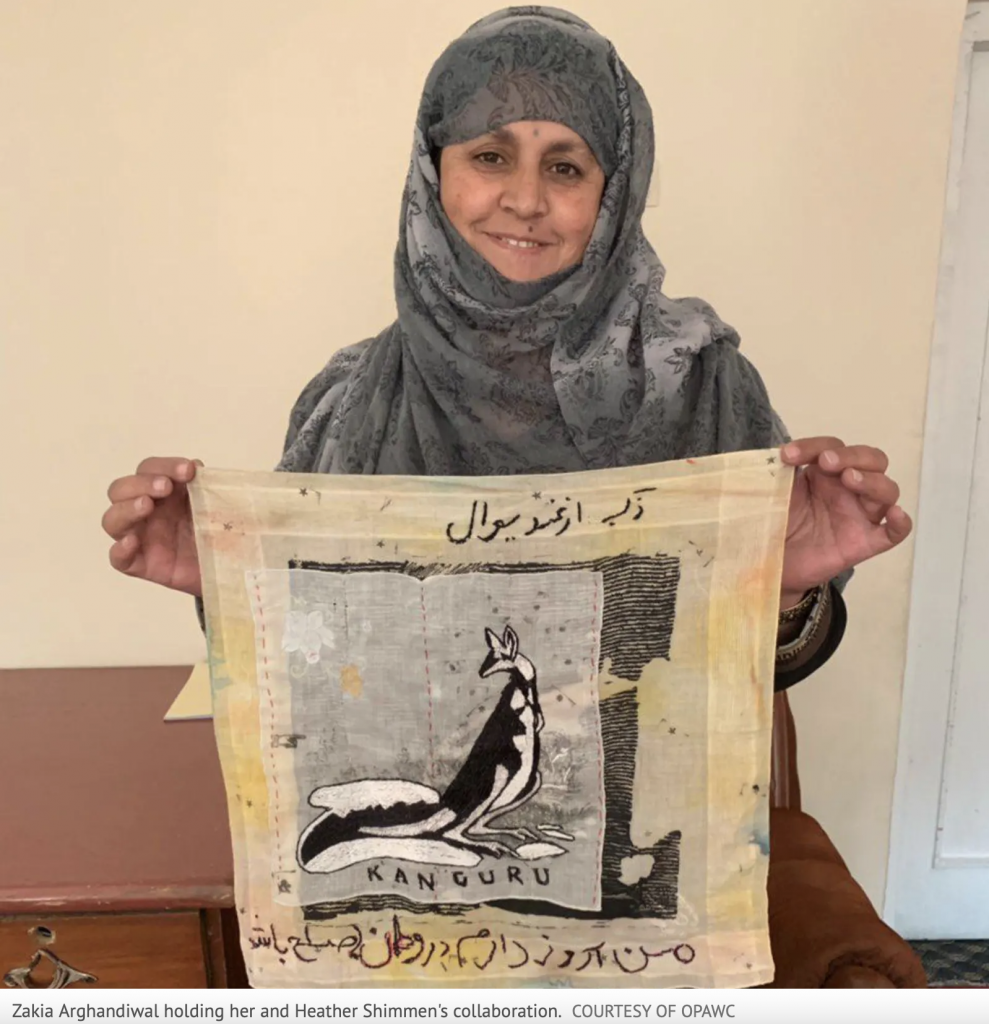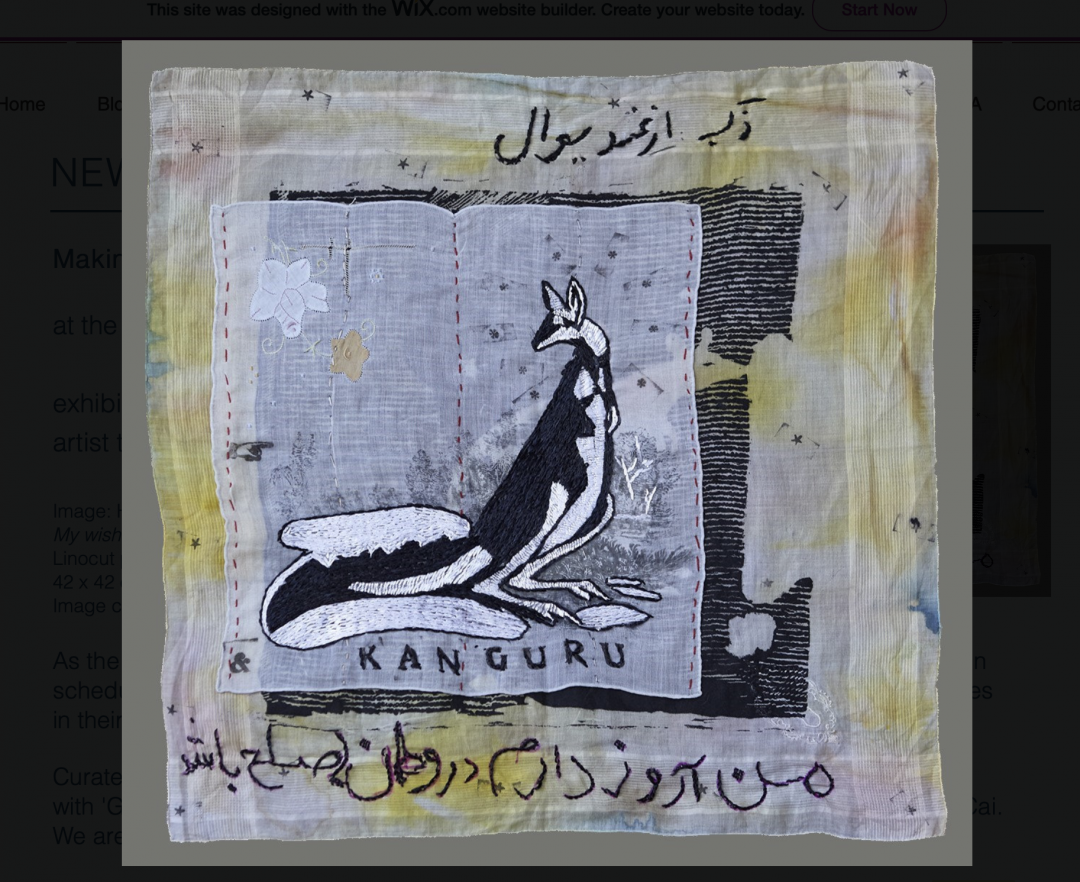Twelve months ago I when wrote this little story on a lovely fusion of crafts and cultures that reached across the planet, life was hard enough for the women and girls of Afghanistan. But the unthinkable – a return to Taliban rule – was just that: blessedly unthinkable. Now the horror. I’m revisiting this story – first published in The Age and Sydney Morning Herald, to reintroduce artist Gali Weiss and her blog harvest from Kabul https://galiweiss.wixsite.com/making-marks-book/blog with a clickable link to the book, not only an elegant artwork in its own right but one small way we might support the women of Kabul at this terrible time: https://galiweiss.wixsite.com/making-marks-book, With love, Janice Breen Burns
This is a complicated story so I will begin with its easy middle when a small flock of rare spotted pardalote birds flew from the northern tip of Bruny Island into Barbara Kameniar’s backyard in the remote southern Tasmanian townlet of Tinderbox. It was late 2017. She knew them well, these fragile, near-extinct, seemingly weightless fingerlings; they’d nested under her house before. “Tiny, exquisite things, incredibly brave, unafraid of the larger birds…” Watching them, Kameniar was anxious, thinking about a looming challenge, but calmed as the little birds ducked and fluttered. “They’re such bringers of joy and excitement and promise of new life….”
Kameniar had been challenged by a friend, the Melbourne artist and printmaker Gali Weiss, to create three artworks for Making Marks, the second of an unusual collaboration with women in Afghanistan called Unfolding Projects. The first project, “Two Trees”, a series of concertina-style books with each folded page by a different Australian printmaker artist, had already forged surprisingly close friendships since they were sent in 2011, to a group of women living and learning literacy and vocational skills a planet away in the toughest suburb of Kabul.
Despite their constricted and often violent lives, the women and girls put their hard-won basic literacy skills to work, “completing” the artists’ pages with their own marks and words before returning the books to Australia. “Two Trees”, its cover a symbolically split panel of native Australian gum once side, and a species indiginous to Afghanistan on the other, is now in the State Library of Queensland.
For the second Unfolding Project, started in 2017, Weiss asked 20 artists, again mostly print makers, to render their works on what she calls the “deeply symbolic, loaded with meaning” media of handkerchiefs. Each artist; three handkerchiefs, three artworks. And in an odd but visionary afterthought, Weiss also asked Kameniar, who had collaborated on “Two Trees” as a facilitator, lubricating links between the Australian and Afghani women with her contacts in Adelaide’s Support Association for the Women of Afghanistan (SAWA) and the Revolutionary Association of Women in Afghanistan, to contribute as an artist.
The request flummoxed and excited Kameniar. “I was so anxious. It’s not my field. I’m not an artist. I’m an educator. ”
But then the birds. “So beautiful, so incredibly brave, so symbolic of freedom.” So perfect a symbol for the women of Kabul. Later, muse in flight, Kameniar would print her linocut of the tiny pardalotes, perched with a whimsically spindly rendition of her beloved Oxford – the symbolic zenith of education – onto three handkerchiefs.
Still later, two of the handkerchiefs would return from Kabul with the poignant thoughts of a woman named Hajira and another, anonymous woman, delicately embroidered like scattered seeds around the birds; “I would like to live in a peaceful environment….”, “I wish to participate in the construction of my country….”,

For Gali Weiss, Unfolding Projects was always about tapping that wellspring of linking words with art. “Back at the beginning, around 2009, I’d just finished a PhD in visual arts and – the timing – I remember there was a high involvement of troops in Afghanistan and a lot of media about the women there, how they were struggling, not only with literacy, with life, some were burning themselves. It was heartbreaking. Some who could write, were writing poetry that amplified the inequality between us as women. I had to do something.”
In the daily flood of news about terrorists’ bombs and daily chaos in occupied Afghanistan, there was also a sub-stream of reports, horrifically peculiar to Afghani women. Somehow, they were managing to survive in a hard-wired misogynist society where male relatives have absolute authority, domestic violence is common, education, economic freedom and basic rights are rare, and human worth is still measured in cows, goats and the ability to breed boys.
Weiss remembers one day, pausing mid-news-stream, mesmerised by a Marie Dorigny photograph in The Age, of Malalai Joya. The world renowned Afghani human rights warrior and parliamentarian is pictured kneeling, writing quietly on the floor of her home in Farah, oblivious as a tiny girl watches her intently through a screen door. “I got quite emotional,” Weiss says. “It was the face of the future, looking in on Malalai. It spurred me on to do, even something tiny, to just take some action, anything, to say, ‘We support you, you’re not alone, we hear you from across the world, keep going…..”‘
In 2018, this second incarnation of Weiss’s connective art series, “Making Marks. Australian and Afghanistan”, including 60 separate “pages” of handkerchiefs rescued or gifted (from grandmothers, mothers, fathers and others) and lovingly covered by 20 Australian artists, (Kamanier’s Oxford pardalotes among them) was hand delivered to Mursal Rahimi, exective director of Kabul’s Organisation of Promotion of Afghan Women’s Capabilities (OPAWC) vocational training centre.
The centre is located in Kabul’s infamous “ghost district” where Jehadi factions battled most ferociously and innocents’ dying was the daily norm. “Almost all the women have symptoms of anxiety and post-traumatic stress disorder,” Rahimi says. “They cannot express their pain but if you look into their faces you will see a thousand stories …
“The lives of Afghan women are very different from the lives of Australian women and other developed countries,” she adds, “It is very difficult for me to describe…”

There are clues, however, as Rahimi translates the women’s embroidered words. “I hope no mother loses her child in an explosion and suicide” is carefully stitched by Kabul girl Karima, into a peaceful bush scene by printmaker Marian Crawford. Another girl, Zainab, sewed the hope of most between the handmade lace edges of printmaker Catherine Pilgrim’s work: “May there be peace in our homeland”.
The clashing juxtaposition of women’s experiences is powerful in the artworks but also visible is the millefeuille of meanings they share despite their disparate geography and cultures. Artist Jennifer Kamp’s graphic rendering of the aftermath of terrifying bushfires in Australia for example, is edged with a simple plea for peace by Madina in Kabul. Gali Weiss’s haunting works explore women’s intimate and exterior worlds in a face with eyes quietly or submissively closed, covered by hands, or with embroidered roses bleeding into their design.
Printmaker Rosalind Atkins layered symbols of three generations of women in her family onto her grandmother’s handmade lace handcerchiefs. On one, she printed snipped fragments from her mother’s wedding gown. For another, she spread the lace-edged cloth under a gum tree in her Alphington backyard, marking where the leaves drifted and slipping an elegantly scrawled print of the word “Life” into the design, a meaningful translation of her mother’s name, Vida.
“I wanted to send that sense of place,” Atkins says. “Of my place. And my mother, and my grandmother, who was a woman with a strong sense of social justice…I think she would see this as a very appropriate use of (her handkerchiefs).”
Atkins wishes there were more she could do for the women on the other side of the planet who touched and stitched and marked the project’s artworks to “complete” them. “You can’t help but think how privilaged we are,” Atkins says. “How (comparatively) safe we are. I wish (the Afghan women) could be empowered, and literacy, eduction, is fundamental to that. If I could change anything for them, it would be to have control over their lives.”
In reality, that is dangerously unlikely. February’s shakey agreement between the US and the Taliban to withdraw troops, exchange prisoners and recognise the current Afghan government, is halting and volatile and fears are growing that women’s rights could again be reduced, as they were under Taliban rule 19 years ago, to those of cattle.
“Afghan women are survivors,” Rahimi says, “They are courageous and hard working…and they will continue to struggle for their rights.”
They also have allies who, once, literally amazed them. “The joy and hope (the women) expressed when they received the artworks from Australia was astonishing to watch,” Rahimi says. “They couldn’t believe they are sent by people of a different culture and from such a long distance. (The artworks) had an immense impact…they touched a sense of connection and friendship with people of different looks and religion who care and supported them. In this deeply ingrained misgynistic society, this kind of support inspire and encourage them to be resilient and hopeful.”
Publication of The Handkerchief Project, by Vivid, was supported by the Australian Cultural Fund
with all sales going to the OPAWC Vocational Training Centre, Kabul.
http://vividpublishing.com.au/makingmarks/
A planned exhibition at the Counihan Gallery as part of the Human Rights Film Festival has been deferred until after the Covid-19 crisis.





